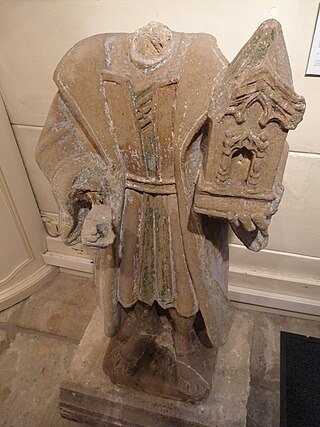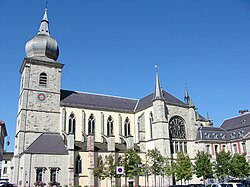
Arnulf of Metz was a Frankish bishop of Metz and advisor to the Merovingian court of Austrasia. He later retired to the Abbey of Remiremont. In French he is also known as Arnoul or Arnoulf. In English he is known as Arnold.

Gerard, also known as Gerard the Wonderful, was a Lotharingian nobleman. He was the count of Metz and Châtenois from 1047 to 1048, when his brother Duke Adalbert resigned them to him upon his becoming the Duke of Upper Lorraine. On Adalbert's death the next year, Gerard became duke, a position that he held until his death. In contemporary documents, he is called Gerard of Alsace, Gerard of Chatenoy, or Gerard of Flanders.

Leopold the Good was Duke of Lorraine and Bar from 1690 to his death. Through his son Francis Stephen, he is the direct male ancestor of all rulers of the Habsburg-Lorraine dynasty, including all Emperors of Austria.

Remiremont is a town and commune in the Vosges department, northeastern France, situated in southern Grand Est. The town has been an abbatial centre since the 7th century, is an economic crossroads of the Moselle and Moselotte valleys, and is also a stepping stone for tourists wishing to explore the Vosges and neighbouring Alsace. Remiremont has got a police station, which covers the city and his suburban area. The fire station realizes more than 2000 interventions per year. Remiremont is also known as the La Belle des Vosges.

Saint Amatus, also called Amatus of Grenoble or Saint Ame or Aimee, was a Frankish Colombanian monk and hermit. Together with St. Romaric, he founded Remiremont Abbey.

Bouzonville is a commune in the Moselle department in Grand Est in northeastern France.

Saint Germanus of Granfelden was the first abbot of Moutier-Grandval Abbey. He is venerated as a martyr saint in the Catholic and Eastern Orthodox Churches.

Saint Romaric was a Frankish nobleman who lived in Austrasia from the late 6th century until the middle of the 7th century. He and Amatus of Grenoble founded Remiremont Abbey.

Anne Charlotte of Lorraine was the Abbess of Remiremont and Mons. She was the thirteenth of fifteen children of Leopold, Duke of Lorraine, and his spouse Élisabeth Charlotte d'Orléans. Her mother was the niece of Louis XIV of France and sister of Philippe II, Duke of Orléans and Regent of France during the minority of Louis XV.

Élisabeth Charlotte Gabrièle of Lorraine was a Princess of Lorraine. She died of smallpox aged 10. She was the Titular Abbess of Remiremont.

Catherine of Lorraine was the Abbess of Remiremont.

Princess Maria Christina of Saxony was a Princess of Saxony and later Abbess of Remiremont.
Dorothea Maria zu Salm (1651-1702), was a German-Roman monarch as Princess Abbess of the immediate Imperial Remiremont Abbey in the Duchy of Lorraine which then formed a part of the Holy Roman Empire, but later on was annexed by France in 1766.
Anne Marie Thérèse of Lorraine, was a Princess of Lorraine and was later a Princess Abbess of the Imperial Remiremont Abbey in France.

Anne Charlotte de Lorraine-Brionne (1755-1786), was a French aristocrat, she was Princess Abbess of the Imperial Remiremont Abbey in France in 1782-1786.
Barbara of Salm (1570–1611), in France called Barbe de Salm, was a German-Roman monarch as Princess Abbess of the Imperial Remiremont Abbey in France.
Marguerite IV d'Haraucourt, (15??–1568), was a German-Roman monarch as Princess Abbess of the Imperial Remiremont Abbey in France. She was abbess twice: a first term 1520–28, and a second in 1544–68.
Madeleine de Choiseul (1500-1578), was a German-Roman vassal as Princess Abbess of the Imperial Remiremont Abbey in France. She was abbess twice, in 1520 and in 1544. She took over upon the death of Alix de Choiseul's death in 1520, who had fulfilled the role from 1507 to 1520. Upon her appointment, it is said that she was not revered by her other Ladies.

Nivelles Abbey is a former Imperial Abbey of the Holy Roman Empire founded in 640. It is located in Nivelles, Walloon Brabant, Belgium.
The House of Luxembourg (or Luxembourg), also known as the House of Ardenne–Luxembourg in order to distinguish it from later families, were a Lotharingian noble family known from the tenth and eleventh centuries. They are one of the three main branches of the House of Ardenne, along with the House of Ardenne–Verdun, and the House of Ardenne–Bar.
















